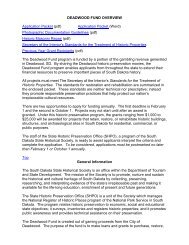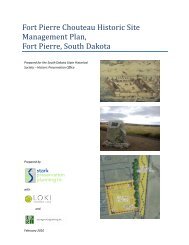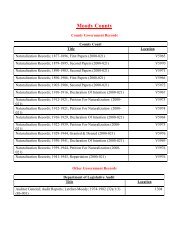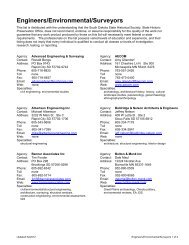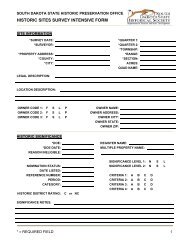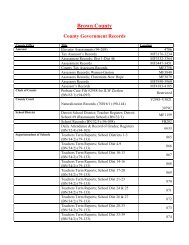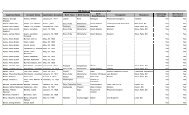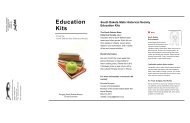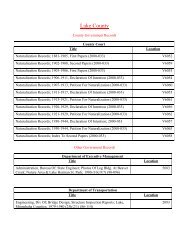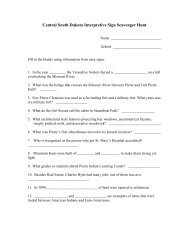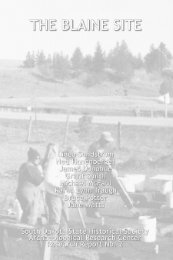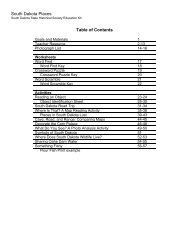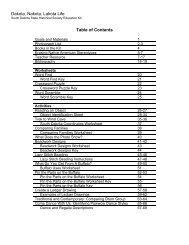A Geoarchaeological Overview of South Dakota and Preliminary
A Geoarchaeological Overview of South Dakota and Preliminary
A Geoarchaeological Overview of South Dakota and Preliminary
You also want an ePaper? Increase the reach of your titles
YUMPU automatically turns print PDFs into web optimized ePapers that Google loves.
DRAFT DRAFT DRAFT<br />
clays, <strong>and</strong> high energy gravels. Gravel content increased with proximity to the valley wall. At the base <strong>of</strong><br />
the Holocene sediments, atop glaci<strong>of</strong>luvial outwash was a stratified organic pond deposit. M<strong>and</strong>el<br />
interpreted the sediments as late Holocene in age, <strong>and</strong> surmised that early sediments had been eroded<br />
from the valley prior to the late Holocene (M<strong>and</strong>el 1993; Fosha et al. 1994).<br />
Level I <strong>and</strong> II surveys for the CENDAK irrigation project (Haug et al. 1983) encountered four buried<br />
sites in the Upper <strong>and</strong> Middle James River in three geomorphic contexts: one in a small draw, two in<br />
larger stream valleys, <strong>and</strong> one on a glacial lake shore. At 39BE115, pottery <strong>and</strong> bison bone were found<br />
in back dirt from a farm pond excavation, <strong>and</strong> interpreted as a buried site impact by construction. The<br />
site is on Turtle Creek, in an outwash valley in the Middle James Region. The Kuhl-Poindexter site<br />
(39FK12) is located on a lower terrace <strong>of</strong> <strong>South</strong> Fork Snake Creek in the Upper James region. Two<br />
meters <strong>of</strong> alluvium was exposed in cutbanks <strong>and</strong> test units. A late prehistoric component is near the<br />
surface, but Woodl<strong>and</strong> ceramics were encountered at an unspecified depth (Haug et al. 1983:72). At<br />
39SP141, in the Upper James Region, artifacts were found at depths <strong>of</strong> 80-100 cm in a cutbank on the<br />
east edge <strong>of</strong> Cottonwood Lake. The geomorphology <strong>and</strong> stratigraphy were not described. At the Majors<br />
Gulch site, 39HD30, cultural material was found at depths <strong>of</strong> 45-80 cm in cutbanks <strong>of</strong> a narrow valley<br />
deeply incised into the Wessington Hills escarpment in the Middle James Region (Haug et al. 1983).<br />
Vermillion Basin/Yankton<br />
M<strong>and</strong>el (1992) identified DeForest Formation alluvium at 39CL10, on the Vermillion River upstream<br />
from its Missouri River confluence. A cutbank <strong>and</strong> backhoe trenches exposed a vertically-stacked<br />
sequence <strong>of</strong> the Gunder, Roberts Creek, <strong>and</strong> Camp Creek members. Two buried soils are formed in the<br />
upper <strong>and</strong> lower parts <strong>of</strong> the Roberts Creek Member, <strong>and</strong> a soil is also developed into the upper part <strong>of</strong><br />
the Gunder Member. Archaeological deposits were present in both the Roberts Creek <strong>and</strong> Gunder strata.<br />
Radiocarbon ages <strong>of</strong> 3260, 3240, <strong>and</strong> 3050 RCYBP were recovered from hearths in the upper part <strong>of</strong> the<br />
Gunder Member, <strong>and</strong> charcoal from the Roberts Creek Member yielded radiocarbon ages <strong>of</strong> 1850 <strong>and</strong><br />
1260 from the lower <strong>and</strong> upper buried A horizons, respectively. The lithology <strong>and</strong> ages <strong>of</strong> the DeForest<br />
Formation at the site are very similar to the characteristics <strong>of</strong> the DeForest Formation in Iowa <strong>and</strong><br />
eastern Nebraska (Bettis 1990; M<strong>and</strong>el <strong>and</strong> Bettis 2000).<br />
Northeast Lowl<strong>and</strong>s<br />
Messerli <strong>and</strong> Donohue (2005) describe the stratigraphy at 39RO10 <strong>and</strong> 39RO117, located on an<br />
outwash terrace between the Minnesota River <strong>and</strong> Lake Traverse. Shovel testing to unspecified depths<br />
did not encounter glacial outwash, suggesting that a loamy mantle <strong>of</strong> some thickness is present on the<br />
sites. At 39RO10, mound-like features <strong>and</strong> adjacent level ground yielded prehistoric habitation evidence,<br />
not mortuary remains or features. One <strong>of</strong> the mounds was underlain by a buried A horizon, <strong>and</strong> the<br />
overburden was interpreted as disturbed topsoil derived from elsewhere on the site. The surface layer,<br />
was interpreted as topsoil storage from constructing the nearby highway, or a post-occupation raising <strong>of</strong><br />
the l<strong>and</strong> surface for an unknown purpose.<br />
The buried soil pr<strong>of</strong>ile is described in detail, but the geologic processes <strong>and</strong> origin <strong>of</strong> the mantle are<br />
not discussed. Elsewhere in the report, the authors note that<br />
“Deposits <strong>of</strong> Late Pleistocene-Holocene loess (i.e., wind-blown sediments) have been noted as thin<br />
veneers atop some lacustrine deposits <strong>and</strong> near-level areas <strong>of</strong> glacial till in the Coteau upl<strong>and</strong>s (Flint<br />
1955: 128). These wind-blown sediments <strong>of</strong> silts <strong>and</strong> fine s<strong>and</strong>s probably derived from local outwash<br />
deposits (Flint 1955:164)” (Messerli <strong>and</strong> Donohue 2005).<br />
Little is known <strong>of</strong> these deposits, including their age, source <strong>of</strong> sediment, thickness, <strong>and</strong> correlation with<br />
regional lithostratigraphic units like the Oahe Formation.<br />
32





